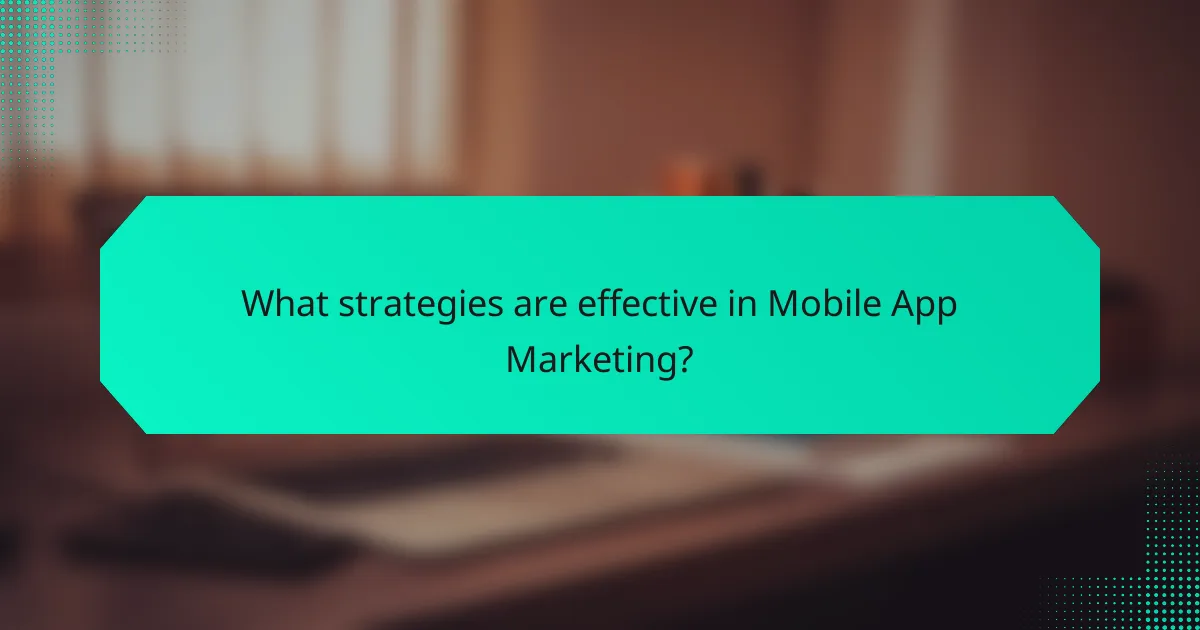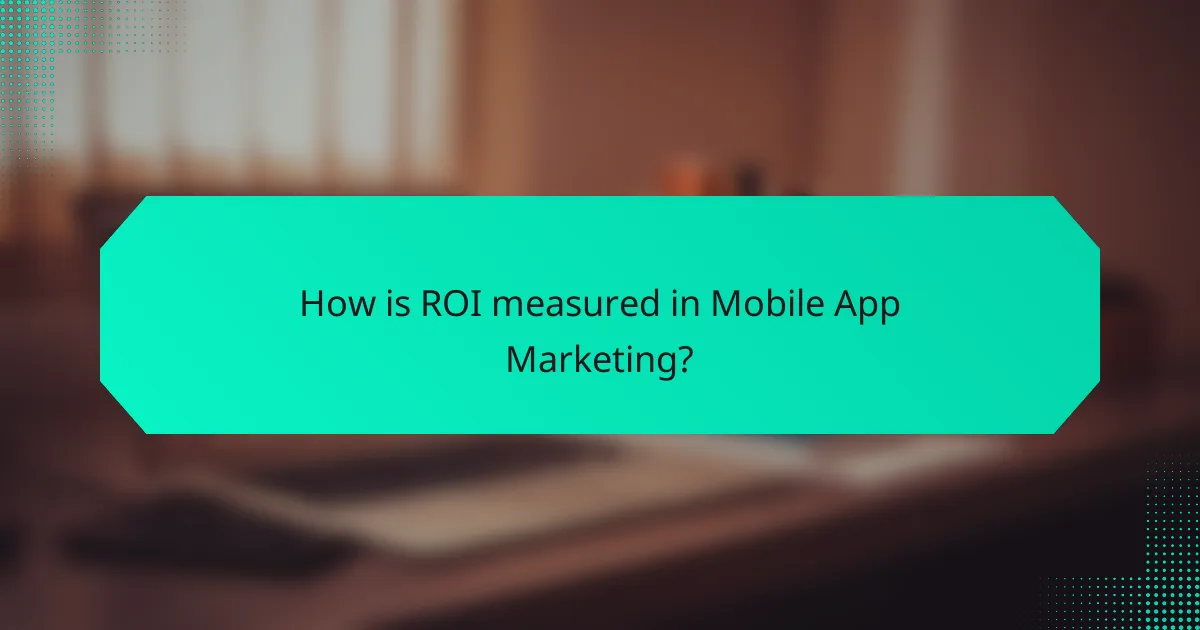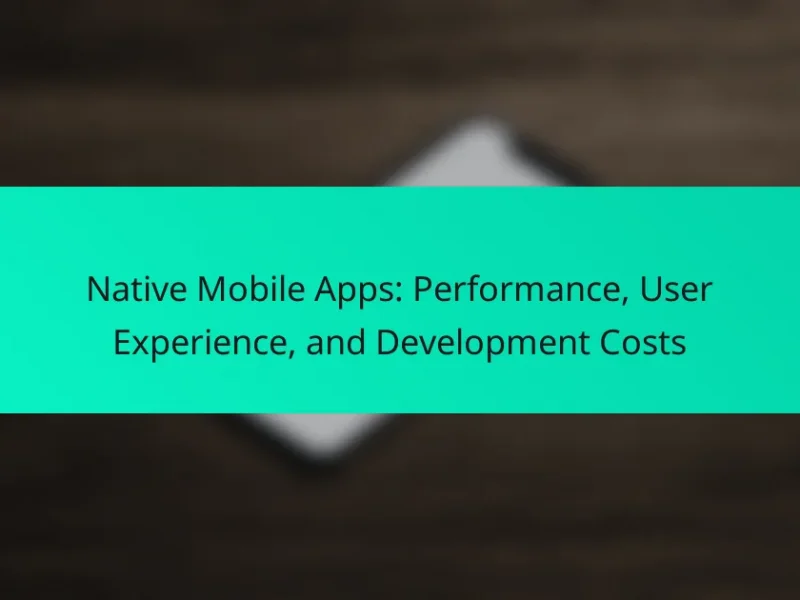Mobile app marketing is the process of promoting mobile applications to enhance visibility and increase downloads. This article outlines various effective strategies, including app store optimization (ASO), social media marketing, influencer partnerships, and email marketing, which are essential for engaging potential users. It discusses key marketing channels such as social media advertising, search engine marketing (SEM), and content marketing, each offering unique advantages for app promotion. Additionally, the article explains how to measure return on investment (ROI) in mobile app marketing through metrics like customer acquisition cost (CAC) and lifetime value (LTV), providing a comprehensive understanding of the financial aspects involved in app marketing.

What is Mobile App Marketing?
Mobile app marketing is the process of promoting mobile applications to increase their visibility and downloads. It involves various strategies and channels to reach potential users. These strategies can include app store optimization, social media marketing, and paid advertising. The goal is to engage users and encourage them to download the app. According to Statista, mobile app revenues are projected to reach $407.31 billion by 2026. This growth highlights the importance of effective mobile app marketing.
How does Mobile App Marketing differ from traditional marketing?
Mobile app marketing differs from traditional marketing primarily in its focus on digital platforms and user engagement. Mobile app marketing utilizes app stores, push notifications, and in-app advertising to reach users directly. Traditional marketing relies on methods like print ads, TV commercials, and billboards to promote products or services.
Mobile app marketing emphasizes data analytics to track user behavior and preferences. This allows for personalized marketing strategies. Traditional marketing often uses broader demographic data, which may not be as precise.
The interactivity of mobile app marketing fosters direct communication with users. This can lead to higher engagement rates compared to traditional marketing, which is generally one-way communication.
According to a report by Statista, mobile app spending is projected to reach $407.31 billion by 2026, highlighting the growing significance of this marketing approach.
What are the key components of Mobile App Marketing?
The key components of mobile app marketing include app store optimization, user acquisition strategies, and user engagement tactics. App store optimization (ASO) enhances visibility in app stores. It involves keyword optimization, compelling visuals, and positive reviews. User acquisition strategies focus on attracting new users through paid advertising, social media, and influencer marketing. These methods can significantly increase downloads. User engagement tactics aim to retain users and encourage in-app activities. These include push notifications, personalized content, and loyalty programs. Together, these components create a comprehensive approach to mobile app marketing that drives downloads and user retention.
Why is Mobile App Marketing essential for app developers?
Mobile app marketing is essential for app developers because it drives visibility and user acquisition. Effective marketing strategies help apps reach their target audience. According to Statista, the number of mobile app downloads reached 258 billion in 2022. This indicates a highly competitive market. Without marketing, an app may remain undiscovered among millions of options. Marketing also aids in user retention and engagement. Developers can leverage analytics to understand user behavior and preferences. This data informs future updates and improvements. Ultimately, successful marketing can lead to increased revenue through in-app purchases and subscriptions.
What are the goals of Mobile App Marketing?
The goals of Mobile App Marketing include increasing app downloads, enhancing user engagement, and boosting retention rates. These objectives drive the overall success of mobile applications in a competitive market. Increasing app downloads is crucial for establishing a user base. According to Statista, mobile app downloads reached 218 billion in 2020, highlighting the importance of visibility. Enhancing user engagement involves creating a compelling user experience. Engaged users are more likely to utilize app features and share the app with others. Boosting retention rates ensures that users continue to use the app over time. Research shows that increasing user retention by just 5% can lead to a 25% to 95% increase in profits. By focusing on these goals, businesses can effectively maximize their app’s potential and achieve a higher return on investment.
How can Mobile App Marketing increase user acquisition?
Mobile app marketing can significantly increase user acquisition by utilizing targeted advertising, optimizing app store presence, and leveraging social media. Targeted advertising allows brands to reach specific demographics, increasing the likelihood of attracting potential users. According to a study by AppsFlyer, targeted campaigns can yield a 30% higher conversion rate compared to non-targeted efforts.
Optimizing app store presence through keyword optimization and engaging visuals enhances discoverability. Research indicates that 70% of app users discover new applications via app store searches. Social media platforms provide an avenue for organic reach and user engagement, which can drive downloads. A report by Statista shows that 54% of users are influenced by social media in their app download decisions.
These strategies collectively create a comprehensive mobile app marketing approach that effectively boosts user acquisition.
What role does user retention play in Mobile App Marketing?
User retention is critical in mobile app marketing as it directly impacts profitability. High retention rates lead to increased lifetime value (LTV) of users. According to a study by Localytics, apps with high retention rates can see up to 3 times more revenue. Retained users are more likely to engage with in-app purchases and advertisements. Retention strategies reduce customer acquisition costs over time. Effective user retention fosters brand loyalty, encouraging users to recommend the app. Consistent updates and user feedback integration enhance user satisfaction. These factors collectively improve the app’s market position and visibility.

What strategies are effective in Mobile App Marketing?
Effective strategies in mobile app marketing include app store optimization, social media marketing, and influencer partnerships. App store optimization enhances visibility and downloads by improving app listing keywords and visuals. Social media marketing engages potential users through targeted ads and organic content. Influencer partnerships leverage established audiences to promote the app authentically. Additionally, email marketing can nurture leads and retain users through personalized communication. Data analytics helps in understanding user behavior, allowing for targeted campaigns. A study by Statista in 2021 found that 60% of users discover apps through app store searches, emphasizing the importance of optimization.
How can content marketing enhance Mobile App Marketing efforts?
Content marketing can significantly enhance mobile app marketing efforts by providing valuable information to potential users. It builds brand awareness through engaging content like blogs, videos, and social media posts. This content can highlight the app’s features and benefits, making it more appealing to users.
Additionally, informative content can improve search engine rankings, driving organic traffic to the app’s landing page. According to HubSpot, companies that prioritize blogging are 13 times more likely to achieve a positive ROI.
Moreover, content marketing fosters user engagement and retention. By offering tutorials, tips, and updates, users feel more connected to the app. This connection can lead to increased downloads and user loyalty over time.
In summary, content marketing supports mobile app marketing by enhancing visibility, engagement, and user retention.
What types of content are most effective for app promotion?
Engaging content types for app promotion include video ads, social media posts, and blog articles. Video ads effectively showcase app features and benefits, increasing user engagement. Social media posts can create buzz and encourage sharing, amplifying reach. Blog articles provide in-depth insights and improve SEO, driving organic traffic. User-generated content, such as reviews and testimonials, builds trust and credibility. Infographics visually summarize app advantages, making them easily shareable. Each content type addresses different user preferences and maximizes promotional impact.
How can storytelling improve user engagement in app marketing?
Storytelling can significantly improve user engagement in app marketing by creating an emotional connection with users. Engaging narratives help users relate to the app’s purpose and benefits. This connection can lead to increased retention rates. According to a study by the Nielsen Norman Group, users are 22 times more likely to remember a story than a fact. Additionally, storytelling can enhance user experience by guiding them through app features in a relatable manner. By presenting challenges and solutions within the narrative, users can better understand how to utilize the app effectively. This method fosters community and loyalty among users, ultimately driving higher engagement levels.
What role does social media play in Mobile App Marketing?
Social media plays a crucial role in mobile app marketing by enhancing visibility and user engagement. It serves as a platform for app promotion through targeted ads and organic content. Brands leverage social media to reach specific demographics effectively. For instance, 79% of users report discovering new apps through social media. Additionally, social media facilitates user feedback and community building around the app. Engaging content can drive downloads and increase user retention. Campaigns on platforms like Facebook and Instagram often yield higher conversion rates compared to traditional marketing methods. Overall, social media is integral in driving app awareness and user interaction.
Which social media platforms are best for promoting mobile apps?
Facebook, Instagram, Twitter, and TikTok are the best social media platforms for promoting mobile apps. Facebook has over 2.9 billion monthly active users, making it ideal for targeted advertising. Instagram’s visual content appeals to younger audiences, enhancing engagement. Twitter facilitates real-time interaction and updates, fostering community around apps. TikTok’s short-form video format is effective for creative app showcases. A study by Statista shows that 60% of users discover new apps through social media. This highlights the effectiveness of these platforms in reaching potential users.
How can influencers impact Mobile App Marketing success?
Influencers can significantly impact mobile app marketing success by enhancing brand visibility and driving user engagement. Their established credibility and large followings facilitate trust among potential users. Influencers create authentic content that showcases the app’s features and benefits. This approach often leads to higher conversion rates compared to traditional advertising methods. According to a study by Nielsen, 92% of consumers trust recommendations from individuals over brands. Additionally, influencer campaigns can improve app store rankings through increased downloads and user reviews. This organic growth can lead to sustained user acquisition and retention.

What channels are available for Mobile App Marketing?
Mobile app marketing utilizes various channels to reach target audiences. Key channels include social media advertising, which enables targeted ads on platforms like Facebook and Instagram. Search engine marketing (SEM) helps increase visibility through paid search results. App store optimization (ASO) enhances app visibility within app stores. Influencer marketing leverages popular figures to promote apps to their followers. Email marketing engages users with updates and promotions. Content marketing provides valuable information that attracts potential users. Additionally, affiliate marketing incentivizes partners to promote the app. Each channel offers unique advantages for app promotion.
How do app store optimization and app store listings affect visibility?
App store optimization (ASO) and app store listings significantly enhance visibility. ASO involves optimizing app metadata to improve search rankings. Key elements include keywords, app title, and description. Effective use of keywords increases the chances of appearing in relevant searches. App store listings, including visuals and user reviews, also impact user engagement. High-quality screenshots and compelling descriptions attract more downloads. Positive user reviews improve credibility and encourage new users. Research indicates that apps with optimized listings see a 20-50% increase in visibility. Therefore, proper ASO and appealing app store listings are essential for maximizing app visibility.
What are the best practices for optimizing app store listings?
The best practices for optimizing app store listings include using relevant keywords in the app title and description. This enhances discoverability in search results. High-quality visuals, such as app icons and screenshots, attract user attention. Clear and concise app descriptions highlight key features and benefits. Regularly updating the app can improve rankings and user retention. Encouraging user reviews and ratings boosts credibility and visibility. Implementing A/B testing on app listings can identify the most effective elements. Analytics tools help track performance and make data-driven adjustments.
How can reviews and ratings influence app downloads?
Reviews and ratings significantly influence app downloads. Positive reviews enhance credibility and attract potential users. High ratings indicate quality and reliability, encouraging downloads. A study by Apptentive found that apps with a 4.5-star rating or higher see a 20% increase in downloads compared to lower-rated apps. Negative reviews can deter users, leading to decreased download rates. Users often rely on peer feedback when choosing apps. This reliance makes reviews a crucial factor in mobile app marketing strategies.
What role do paid advertising channels play in Mobile App Marketing?
Paid advertising channels are essential for driving user acquisition in mobile app marketing. They enable app developers to reach targeted audiences effectively. These channels include social media ads, search engine marketing, and display advertising. Each channel allows for precise targeting based on user demographics and behaviors. For example, Facebook Ads can target users based on interests and location. This targeted approach increases the likelihood of app downloads. According to a study by AppsFlyer, paid user acquisition strategies can yield a 30% higher return on investment compared to organic methods. Paid advertising also provides measurable results, allowing marketers to optimize campaigns in real-time.
Which paid advertising platforms are most effective for mobile apps?
Facebook Ads, Google Ads, and Apple Search Ads are the most effective paid advertising platforms for mobile apps. Facebook Ads offer extensive targeting options and high engagement rates. Google Ads provides access to a vast network, including search and display ads. Apple Search Ads specifically target users within the App Store, leading to high conversion rates. According to a report by AppsFlyer, Facebook Ads have a 30% higher return on investment compared to other platforms. Additionally, Google Ads can drive significant app installs, with a 20% increase in install rates reported by advertisers. These platforms collectively dominate the mobile app advertising landscape due to their effectiveness and reach.
How can retargeting ads improve app user acquisition?
Retargeting ads can significantly improve app user acquisition by re-engaging users who have previously interacted with the app. These ads remind potential users of the app’s value, prompting them to reconsider downloading it. According to a study by AdRoll, retargeting can increase conversion rates by up to 150%. This is because users who see retargeting ads are 70% more likely to convert than those who do not. Additionally, retargeting helps maintain brand awareness, keeping the app top of mind for users. By leveraging user data, advertisers can tailor messages to specific user behaviors, enhancing relevance and effectiveness. Overall, retargeting ads create a more personalized experience, driving higher user acquisition rates.

How is ROI measured in Mobile App Marketing?
ROI in mobile app marketing is measured by calculating the revenue generated from the app against the costs incurred in marketing it. The formula used is ROI = (Net Profit / Cost of Investment) x 100. Net profit is determined by subtracting total marketing costs from the revenue earned through the app. Key metrics include customer acquisition cost (CAC) and lifetime value (LTV) of users. Tracking these metrics allows marketers to assess the effectiveness of their campaigns. For instance, if an app generates $10,000 in revenue with $2,000 in marketing costs, the ROI would be 400%. This indicates a successful marketing strategy.
What metrics should be tracked to measure the success of Mobile App Marketing?
Key metrics to track mobile app marketing success include user acquisition cost, retention rate, and lifetime value. User acquisition cost measures the expense to gain a new user. Retention rate indicates the percentage of users who continue using the app over time. Lifetime value estimates the total revenue a user generates throughout their engagement.
Additionally, conversion rate tracks the percentage of users who complete a desired action. Daily and monthly active users provide insights into user engagement levels. Churn rate measures the percentage of users who stop using the app within a specific timeframe.
These metrics collectively offer a comprehensive view of marketing effectiveness. For example, a high retention rate often correlates with a successful user experience. Tracking these metrics allows marketers to optimize strategies and improve ROI.
How can user lifetime value be calculated?
User lifetime value (ULV) can be calculated using the formula: Average Revenue Per User (ARPU) multiplied by the average customer lifespan. ARPU is determined by dividing total revenue by the number of users over a specific period. The average customer lifespan is the duration a user typically engages with the app before churning. For example, if an app generates $100,000 in revenue from 1,000 users in a year, the ARPU is $100. If the average customer lifespan is 3 years, the ULV is $100 multiplied by 3, resulting in $300. This calculation helps businesses assess the long-term value of acquiring new users.
What is the importance of conversion rates in measuring ROI?
Conversion rates are crucial in measuring ROI as they indicate the effectiveness of marketing efforts. A higher conversion rate signifies that more users are taking desired actions, such as making purchases or signing up. This directly correlates with increased revenue, making it a key metric for assessing financial performance. For instance, a study by WordStream shows that businesses with higher conversion rates can see a 200% increase in ROI. Thus, tracking conversion rates helps marketers optimize strategies for better financial outcomes.
What tools are available for tracking and analyzing Mobile App Marketing performance?
Tools available for tracking and analyzing Mobile App Marketing performance include Google Analytics for Firebase, App Annie, and Mixpanel. Google Analytics for Firebase provides insights into user engagement and retention. App Annie offers market data and competitive analysis for app performance. Mixpanel specializes in user behavior analytics and funnels. These tools help marketers optimize their strategies and improve ROI. Each tool delivers specific metrics that inform marketing decisions and track campaign effectiveness.
How can analytics platforms improve marketing strategy?
Analytics platforms can enhance marketing strategy by providing data-driven insights. These platforms collect and analyze user behavior data. This information helps marketers understand customer preferences and trends. Analytics platforms also enable segmentation of target audiences. By identifying specific user groups, marketers can tailor their campaigns effectively. Additionally, real-time analytics allow for quick adjustments to marketing tactics. This responsiveness can significantly improve campaign performance. According to a study by McKinsey, companies that leverage analytics effectively can improve their marketing ROI by 15-20%.
What role does A/B testing play in optimizing app marketing campaigns?
A/B testing plays a critical role in optimizing app marketing campaigns. It allows marketers to compare two versions of an app element to determine which performs better. This method helps identify user preferences and behaviors. For instance, a study by Optimizely found that A/B testing can increase conversion rates by up to 30%. By analyzing user interactions with different app features, marketers can make informed decisions. This leads to improved user engagement and retention. Ultimately, A/B testing enhances the effectiveness of marketing strategies.
What are some best practices for maximizing ROI in Mobile App Marketing?
To maximize ROI in mobile app marketing, focus on targeted user acquisition strategies. Utilize data analytics to identify and reach your ideal audience. Implement A/B testing to optimize ad creatives and messaging. Leverage social media platforms for cost-effective advertising. Monitor and analyze user engagement metrics regularly. Use push notifications to re-engage users and drive retention. Collaborate with influencers to enhance brand visibility. Invest in app store optimization to improve discoverability. According to a report by AppsFlyer, targeted campaigns can increase ROI by up to 300%.
How can continuous optimization improve marketing outcomes?
Continuous optimization enhances marketing outcomes by systematically refining strategies based on performance data. It allows marketers to identify which campaigns yield the best results. By analyzing metrics such as click-through rates and conversion rates, adjustments can be made in real-time. This iterative process leads to improved targeting and messaging. Research shows that companies utilizing continuous optimization see a 20% increase in ROI. Additionally, A/B testing during optimization helps in determining the most effective content. Overall, continuous optimization fosters agility in marketing efforts, ensuring resources are allocated efficiently.
What common pitfalls should be avoided in Mobile App Marketing?
Common pitfalls in mobile app marketing include neglecting user research, which leads to misaligned features and target audiences. Failing to optimize app store listings can result in poor visibility. Ignoring user feedback may cause retention issues. Overlooking analytics prevents informed decision-making. Underestimating the importance of a marketing budget can hinder reach. Lastly, not having a clear user acquisition strategy can lead to wasted resources. Each of these pitfalls can significantly impact the success of a mobile app in a competitive market.
Mobile app marketing is the process of promoting mobile applications to enhance visibility and drive downloads through various strategies such as app store optimization, social media marketing, and paid advertising. The article explores the differences between mobile app marketing and traditional marketing, highlighting the importance of user engagement and data analytics. Key components of effective mobile app marketing include user acquisition tactics, retention strategies, and the role of social media and influencers. Additionally, the article discusses how to measure ROI through metrics like user acquisition cost and lifetime value, emphasizing best practices for maximizing marketing outcomes and avoiding common pitfalls.


